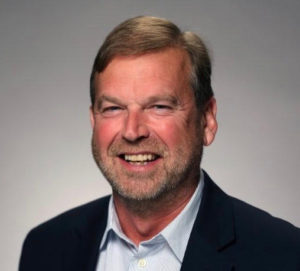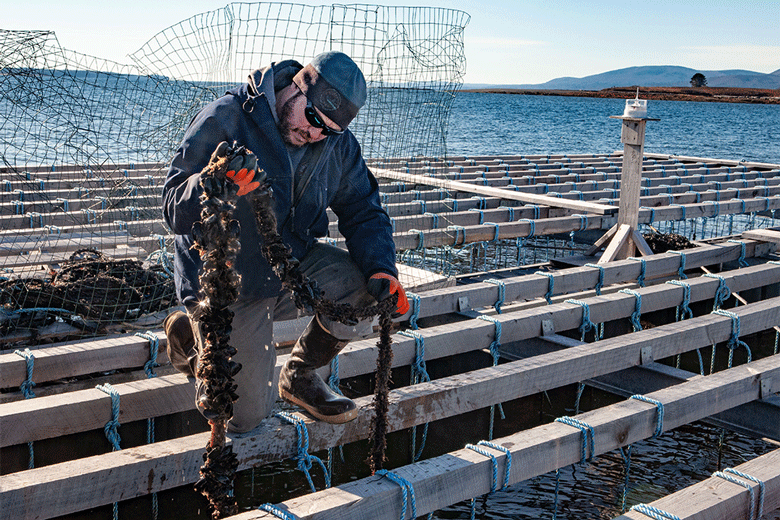When it comes to aquaculture, it would be hard to top Sebastian Belle’s resumé. Belle, 62, earned a degree in fisheries and wildlife at the University of Massachusetts in Amherst, fished offshore for a time, then moved to Europe.
“I was able to get a job in Norway on an aquaculture farm,” he recalls. “I happened to be in the right place at the right time. That was in the very early days of the salmon industry, and they were making a lot of money and investing it all around the world, and they sent me all around the world, building projects,” raising salmon, shrimp, trout, and scallops.
“There’s no question there’s demand. We can sell everything we grow…”
Belle returned to Maine and moved to Eastport, where he managed a series of salmon farms for five years, then worked at Boston’s New England Aquarium for five years in research and development for farming bluefin tuna.
Then it was back overseas to build tuna farms in Spain, France, Mexico, and Australia.
“And then I came back. Angus King pestered me enough,” he laughs, saying the then-governor “wanted private sector people to come work in state government.” Belle became a senior policy advisor on aquaculture for the Department of Marine Resources. He also served on the board of the Maine Aquaculture Association, which was founded in 1977.
In 2000, as aquaculture faced criticism in many circles, he remembers being “pretty frustrated in telling our side of the story. We were always seemingly in defensive mode.” Those at the association challenged him to help, and Belle joined as executive director.
The following interview was edited for length and clarity.
The Working Waterfront: Would you characterize the state of aquaculture in Maine now as kind of a second boom from those late ‘80s, early ‘90s years?
Belle: I wouldn’t call it a boom. We had a period where we were flat. We did not increase our acreage or the number of farms significantly for almost a 20-year period. There was an initial growth period where we grew from about 20 or 30 acres to 600 acres in the late ‘70s to the mid-‘80s. Then it stayed flat.
We had another expansion to around 1,200 acres, and we stayed at that for ten or 15 years. Now we have grown 400-450 acres in the last ten years or so.
The U.S. aquaculture sector has actually contracted slightly over the last 20 years, driven mostly by the contraction in the catfish industry. Our growth rate nationally for the last 20 years has been about 1 percent. The growth rate for the last 20 years in Maine has been roughly 2 percent per year. But the growth rate internationally has been 8 percent per year.

The thing that has caught people’s eyes is the number of limited purpose aquaculture licenses, the LPAs. Those are 400 square feet, designed to allow somebody to try aquaculture, or to prospect in an area. Those numbers have increased quite significantly. The program was created about ten years ago, and in the first year we had five, and now there are, I think, 700-plus. But if you add up the acres, that’s roughly seven additional acres.
LPAs have lowered the barrier to entry, particularly for small owner-operators. Some will become commercial farms, and some won’t. The maximum you can have is four LPAs.
Some of this growth has been driven by the training academies we’ve been running for almost 15 years, in cooperation with Sea Grant and the Island Institute. Roughly 300 people have been through those programs, and about 60 percent have started at some level in aquaculture.
WW: Does the international growth rate of 8 percent suggest to you that there is the opportunity for a lot more growth in Maine?
Belle: There’s no question there’s demand. We can sell everything we grow—an oyster, or a mussel, or a salmon, or a seaweed—between 10 and 20 percent more than our competitors.
We have an advantage in the fresh market—which is essentially Chicago, east and Atlanta, north—that’s between 120 and 130 million consumers. We can get product to market, in that big circle, within 24 hours.
Will we be able to get social license to build farms? There’s certainly plenty of space. We’re currently at almost 1,700 acres out of about 3 million acres in state waters. As of last year, we had an aquaculture facility in every town on the coast of Maine.
In most of those communities, with very few exceptions, you wouldn’t know those farms were there. They’re relatively small scale. The exceptions would be Eastport, where salmon has become part of that community; Damariscotta, where oyster farming has become part of that community; as well as Downeast, where mussel and oyster growing has become more obvious in those communities.
WW: You mention mussels and seaweed and oysters—are there any particular products in the live market that seem to be poised for real success more than others? I know that kelp has come on the scene most recently, but is there anything you think would be “hot” in the market going forward?
Belle: Kelp is hot. It is quite astounding to see the growth there in terms of pounds of product. If you look at what is being put out in the water in seeded line, you’re looking at quite a substantial increase.
There’s tremendous opportunity for growth in mussels on the coast of Maine. We have incredible growing conditions. The mussels that are produced here, people absolutely love and pay a lot of money for. And then oysters, I think there’s still opportunity there. The challenge is the COVID-19 situation has put a hurt on the oyster markets because many people don’t know how to shuck them. They’re used to going to restaurants to buy them, but if they have to shuck them themselves, that is a bit of a barrier.
The exciting thing about the seafood sector in general, with respect to COVID, is we’ve seen a 30-45 percent increase in retail sales in this country. To have that level of increase in a food sector in one year is astounding. That was obviously offset by the virtual collapse in the restaurant sector.
The fact that 80 percent of seafood in this country was consumed in restaurants pre-COVID meant that everybody took a huge hit.
What we are cautiously hopeful for—all of us in the seafood sector—is that those retail sales will hold once we get past COVID, and the restaurant sales will rebound. Maine should be very well positioned to capitalize on that.
WW: The industry had sort of a black eye at some point. It seemed to me that in the late ‘80s, early ‘90s, there was a public pushback on feed, and feces going onto the bottom, gear breaking apart and ending up on beaches. To what do you attribute that? Was it under-regulation, or a gold-rush mentality?
Belle: All the stuff you allude to was the product of young people learning as they were going. And we made mistakes. We made lots of them. One of the reasons we founded the training academies was to try to help new farmers not make those mistakes.
The industry in Maine is actually regulated quite heavily. If you look at the legislative history in Maine, there has not been a year where there have not been significant changes. The kinds of concerns that are being voiced now are no different than those articulated in the past. And they are generally driven by an individual lease application where somebody who owns a very nice house on the shore decides they don’t want that farm in front of their house.
Opponents realized that opposing a farm because of view scape impacts was not going to cut it in front of the legislature or the resource management agencies. So they started organizing the local fishing community. And I would suggest it was a very cynical and premeditated method to use one working waterfront community against another.
WW: Lobstermen see aquaculture as a threat to their fishing grounds. What are they missing if it is really not a threat?
Belle: They’re being told it’s a threat by opposition groups. They need to go read the rules. If there’s a significant fishery there, no one’s going to get a lease. There’s been a very intentional strategy to scare people to say, “One person can own up to 1,000 acres.” It’s just not true.
WW: DMR has a bill before the legislature this session. What are the highlights?
Belle: The LPA (limited-purpose aquaculture) system has been very effective, but people have used it to “game” the leasing system. So what you’ll get is a family where dad has four LPAs, mom has four LPAs, the two kids will have four… And suddenly, you have what is effectively a commercial operation.
We went to the department several years ago, and the department had been thinking the same thing. The LPA holder has to be present while the assistant is there, and there can be up to four assistants.
Sebastian Belle serves on the board of trustees of the Island Institute, publisher of The Working Waterfront.





